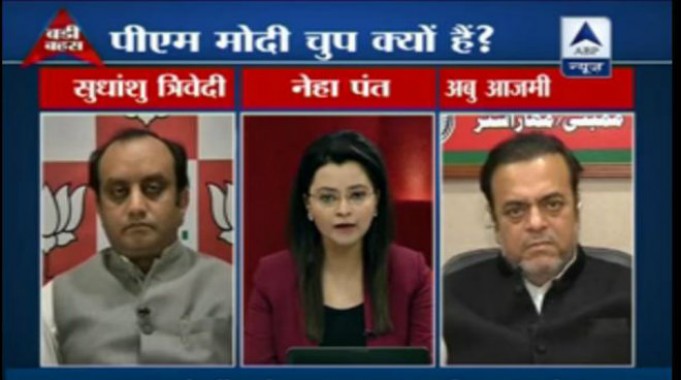Peepli Live redux
There were endless TV discussions on Dadri.
Remember Peepli Live, the acclaimed film about a poor farmer in a drought-hit area who unwittingly became the centre of controversy and how he was caught in a battle between media houses for TRPs and politicians for political mileage?
That was a movie but don’t we have Peepli Lives playing out almost every day, whether it’s over a minor topic or a major issue? In the form of 24/7 running commentary in print, online and television media? In netas cashing in on any controversy? In the reckless and uncontrolled social media where radicalised minds spread poison and tend to trivialise the most important news?
The Dadri tragedy shows once again how the media are feeding off tragedies and from dubious motives. Is it because they really believe the news to be important or is it because a mob lynching lends itself to hysterical reporting and shrill debates which is what they need for their ratings? The same applies to politicians: is that they really care about Akhlaq and the issues the lynching threw up or are they exploiting the murder for their votebanks?
In Peepli Live, politicians and journalists competed for TRPs. They were there again at Dadri. This time we had the social media to give them company. The media were quick to accuse politicians of being vultures but were they any different?
Controversial BJP politicians and leaders from other parties lined up at the village to make provocative statements in their attempts to polarise ordinary people and politicise the issue in a bid to grab the headlines.
These politicians and journalists hung around for so long after the incident that the villagers stopped anyone else from entering because they were so angry at being exploited. The media failed to learn a lesson.
Is it possible that the media and the political class are making a bad situation even worse with their behaviour, that they are exacerbating social tensions because of their insanely aggressive conduct at such times? If the villagers had been left alone after the gruesome murder and after the initial reporting, it’s possible that the social fabric of the village might have been only slightly, or temporarily, damaged and Hindus and Muslims might have been able to resume living together as they had earlier. Instead, as the days passed, differences hardened.
For Akhlaq’s family, the continuous glare of cameras was certainly not something they wanted at this moment of grief when Danish was still in hospital. Surely the media can show more sensitivity and judgement on such occasions and balance the insatiable need of the beast for news and updates with some consideration for the family’s need? Instead, the headlines kept coming:
Mohammad Akhlaq's Son Shifted to Delhi Army Hospital - NDTV
Mohammad Akhlaq's family moves to New Delhi - India Today
Akhlaq’s brother says family will not leave the village — firstpost.com
Kin return to village one last time – Times of India
‘Danish doesn’t want to remember that night’ - Hindustan Times
The cameras continued to chase the family for a byte or two even when Sartaj, the victim’s elder son, visited the village for the first time after the incident.
Negative, positive, analytical, sensational, the issue hogged the headlines for a good two weeks:
Right-wing groups behind Akhlaq killing: Cong - Times of India.
Dadri lynching: Akhlaq's last call was to his Hindu childhood friend for help - Times of India
'I'll become Hindu, but don't hurt my family': Dadri Muslim - catchnews.com
‘Bisada has become a dangerous word’ - Indian Express’
Dadri: Not just another issue, Bhainsko danda? - edit page, Times of India
Was the Dadri lynching really about eating beef - Reddif.com
Dadri incident a well-planned conspiracy - The Hindu
The Dadri effect: Killing beef-eaters will not win elections - Times of India
'Grand Alliance' Trying to Divert Attention by Raising Dadri Incident: Venkaiah Naidu - NDTV
Dadri incident being used for gains in Bihar polls: Sanjay Raut - CNN -IBN
Adding to the pandemonium was the social media, which has become a loose cannon of sorts. It behaved very irresponsibly with people posting hate comments and inflammatory pictures. A photo of raw flesh was circulated with the claim that it was the beef found in Akhlaq’s house. The police haven’t been able to trace the people who started these chain messages. However, the ‘once-bitten, twice-shy’ UP police quickly managed to zero in on a Facebook user for posting videos of a Dalit couple who stripped at a police station in nearby Dankaur.
After the Dadri incident, there was a string of rumours over ‘cow carcasses being found all over UP’. In Mainpuri, two butchers were beaten up over rumours of cow slaughter. Even in Bisada, the carcass of an animal led to fresh tension days after the lynching. Hate messages spread on the social media and messaging apps were largely responsible for such incidents.
And now politics has started over the decision of many writers to return their Sahitya Akademi awards to protest against the growing intolerance in the country. The government has termed it a ‘manufactured’ protest and the opposition has taken the government head-on. Here we go again..yet another controversy, yet another high-decibel ruckus. Where will it end? The mind boggles.
(Kakoli Thakur is an independent journalist with a blog: kakolithakur.blogspot.in)








_150_200.jpg)